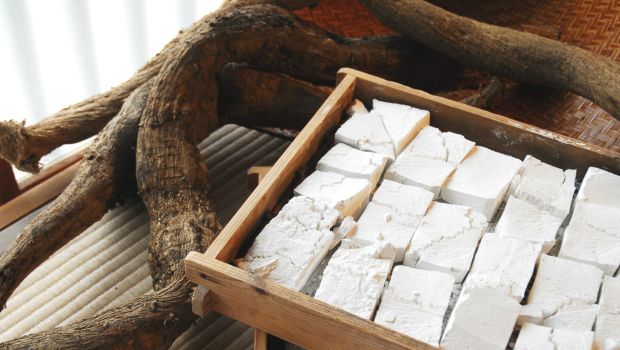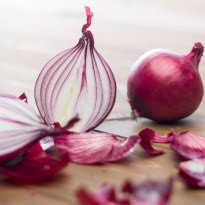
I watched the lined-up buckets fill with brackish brown water as they sat on a bare concrete floor, wet with icy cold water. Not far from them were snow-white blocks of almost-finished product in wooden containers, undergoing a final drying process.
What a stark contrast. This production of kudzu-ko, or arrowroot starch, requires only a plant’s rhizome and clean well water (the brown water is the result of washing the rhizomes to remove impurities). The skin comes off during a rolling process that eventually creates the snow-white powder.
This pure white kudzu-ko has been produced at the small, rural, family-owned factory called Kurokawa Honke in Nara Prefecture, Japan, for more than 400 years.
Why we need kudzu-ko
When the end of the year approaches, I make sure to have sufficient stock of kudzu-ko in my pantry. Festivities during this season may lead me to over-indulge in rich food and alcoholic beverages. When matters go to excess, my body’s immune system seems to weaken and I am vulnerable to sickness.
My mother knew how to fix me up when I was down with such problems. She made me a piping hot, thick-textured drink called kudzu-yu that warmed the body, strengthened the immune system and soothed the stomach. It always worked.
Kudzu-yu is made from kudzu-ko and piping hot water. My mother flavored it with freshly squeezed ginger juice, salty and sour ume plum, sweet azduki bean paste or fragrant yuzu juice.
Arrowroot’s many uses
The kudzu plant has played an important role in Japan since ancient times (and is today an invasive plant in the Southeastern United States.). Its little purple flower, which blooms toward the end of August, was much admired by our ancestors, and has been a constant subject of poetry and paintings since the eighth century. The flower was used to cure a hangover. The leaves were fed to animals. The bark of the root was spun into cloth. The starch inside the rhizome was used as medicine.
Starches used to produce delicious dishes can be found around the world — tapioca starch for Brazilian tapioca crepe and Taiwanese tapioca pearl tea; corn starch for American fruit pie filling; sago starch for New Guinea’s sago pancakes. Today, modified starches are more prevalent than natural ones.
I would like to share with you how the purest natural kudzu starch has been produced since 1615 at Kurokawa Honke. The process I witnessed was like watching an ugly duckling become a snow-white swan.
How kudzu-ko is made
Kudzu-ko is obtained from the thick, long rhizome of kudzu plant that grows quite large, and looks as ugly as can be.
How our ancestors found the edible starch trapped inside the rough fibrous bark is lost in the clouds of culinary history. They may have encountered a wild boar digging up the root and enjoying the starch trapped inside.
The rhizome begins to store starch toward the end of November, and it grows larger each year. Kurokawa Honke uses seven- or eight-year-old rhizomes, each averaging three feet in length and weighing about 33 pounds. The production of kudzu-ko must be done during cold months when fewer microbes are in the air, assuring safe production.
The rhizome is put into a roller machine to soften and break up the bark and starch. The processed rhizome is then rinsed in a bucket of spring water to expose the interior starch. This starch is mixed with new water and left overnight.
The next day, the dirty dark brown water with impurities is removed and clean water is added to the buckets, mixed with the starch, and left again. This process is repeated five to seven times until all impurities are gone, and the resulting starch is strikingly white. The moist starch is then cut into blocks the size of tofu bricks.
They are placed in a paper-lined wooden container and dried for two months in a dark, freezing-cold part of the 400-year-old factory.
The dried blocks naturally collapse into small pieces — each 33-pound rhizome produces only 3 pounds of starch. Kurokawa Honke is committed to producing kudzu-ko by this traditional artisan method.
“It is company’s responsibility to produce delicious, safe-to-consume, beneficial to human health and an environmentally friendly product,” says Shinichi Kurokawa, chief production manager, who will become the 13th-generation president of the company.
My own modifications
Since I moved to America, I have modified my mother’s kudzu-yu drink to provide a thinner texture that is more appealing to people in my adopted country. I flavor it with American favorites such as chocolate and cinnamon-scented apple sauce.
Try the recipe below and enjoy this new body-warming, stomach-soothing and mentally comforting drink during this holiday season. While sipping it, close your eyes and picture the image of the transformation of an ugly duckling to a snow-white swan.
1. Body and Soul Warming Apple, Ginger Kudzu-yu Drink
Total time: 3 minutes
Yield: 1 serving
Ingredients
8g kudzu-ko
2 teaspoons water
¾ cup apple juice
Ginger juice, squeezed from grated fresh ginger, to taste
Cinnamon powder, if desired
Directions
In a small cup, mix the kudzu-ko and 2 teaspoons water with your finger until the starch is all dissolved.
In a small saucepan, add the dissolved kudzu-ko with water and apple juice. Put the saucepan over medium heat and cook the mixture, stirring, all the time with a spatula. Within 1 minute it will start to thicken. Continue stirring for 1 minute. Add the ginger juice, and cinnamon powder, if you are using. Serve the kudzu-yu hot in your favorite coffee or tea mug.
2. Quick & Easy Kudzu-ko Chocolate Mousse
Total time: 5 minutes
Yield: 4 to 5 ¼-cup size serving cups
Ingredients
15g kudzu-ko
2 tablespoons + ¼ cup water
2 tablespoons cocoa powder
¾ cup heavy cream
3 tablespoons sugar
50g baking chocolate, cut into small pieces
Pinch of sea salt
Directions
In a small saucepan, dissolve the kudzu-ko with 1 tablespoon water. Add cocoa powder and 1 tablespoon water, and mix with kudzu-ko. Add the heavy cream and remaining ¼ cup water.
Place the pot over moderately high heat and cook, stirring with a spatula all the time for 1 to 2 minutes. The mixture will start to thicken. Turn the heat to low and continue to stir until the mixture is smooth and blended.
Add the sugar, chocolate and pinch of salt, and cook until the chocolate melts, about 2 minutes, stirring all the time. Transfer the chocolate mousse into 4 to 5 small cups. Chill the chocolate mousse before serving.
[“source-ndtv”]










